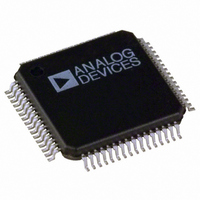ADV7311KST Analog Devices Inc, ADV7311KST Datasheet - Page 53

ADV7311KST
Manufacturer Part Number
ADV7311KST
Description
IC VID ENC 6-12BIT DAC'S 64LQFP
Manufacturer
Analog Devices Inc
Type
Video Encoderr
Datasheet
1.ADV7311KST.pdf
(84 pages)
Specifications of ADV7311KST
Rohs Status
RoHS non-compliant
Applications
DVD, SD/HD
Voltage - Supply, Analog
2.5V
Voltage - Supply, Digital
2.5V
Mounting Type
Surface Mount
Package / Case
64-LQFP
Input Format
Digital
Output Format
Analog
Supply Voltage Range
2.375V To 2.625V
Operating Temperature Range
0°C To +70°C
Tv / Video Case Style
LQFP
No. Of Pins
64
Msl
MSL 1 - Unlimited
Lead Free Status / RoHS Status
Lead free / RoHS Compliant
Available stocks
Company
Part Number
Manufacturer
Quantity
Price
Company:
Part Number:
ADV7311KST
Manufacturer:
ADI
Quantity:
300
Company:
Part Number:
ADV7311KST
Manufacturer:
Analog Devices Inc
Quantity:
10 000
Part Number:
ADV7311KSTZ
Manufacturer:
ADI/亚德诺
Quantity:
20 000
Coring Gain Border
[Address 63h, Bits 3–0]
These four bits are assigned to the gain factor applied to
border areas.
In DNR mode, the range of gain values is 0 to 1 in increments
of 1/8. This factor is applied to the DNR filter output, which
lies below the set threshold range. The result is then subtracted
from the original signal.
In DNR sharpness mode, the range of gain values is 0 to 0.5 in
increments of 1/16. This factor is applied to the DNR filter
output, which lies above the threshold range.
The result is added to the original signal.
Coring Gain Data
[Address 63h, Bits 7–4]
These four bits are assigned to the gain factor applied to the
luma data inside the MPEG pixel block.
In DNR mode, the range of gain values is 0 to 1 in increments
of 1/8. This factor is applied to the DNR filter output, which
lies below the set threshold range. The result is then subtracted
from the original signal.
In DNR sharpness mode, the range of gain values is 0 to 0.5 in
increments of 1/16. This factor is applied to the DNR filter
output, which lies above the threshold range.
The result is added to the original signal.
DNR Threshold
[Address 64h, Bits 5–0]
These six bits are used to define the threshold value in the range
of 0 to 63. The range is an absolute value.
Border Area
[Address 64h, Bit 6]
When this bit is set to a Logic 1, the block transition area can be
defined to consist of four pixels. If this bit is set to a Logic 0,
the border transition area consists of two pixels, where one pixel
refers to two clock cycles at 27 MHz.
REV. A
DNR27 – DNR24 = 01h
720 485 PIXELS
(NTSC)
Figure 49. DNR Offset Control
Figure 50. DNR Border Area
APPLY DATA
CORING GAIN
O X X X X X X O O X X X X X X O
O X X X X X X O O X X X X X X O
O X X X X X X O O X X X X X X O
8 8 PIXEL BLOCK
APPLY BORDER
CORING GAIN
BORDER DATA
2-PIXEL
8 8 PIXEL BLOCK
OFFSET CAUSED
BY VARIATIONS IN
INPUT TIMING
–53–
Block Size Control
[Address 64h, Bit 7]
This bit is used to select the size of the data blocks to be pro-
cessed. Setting the block size control function to a Logic 1 defines
a 16 pixel × 16 pixel data block, and a Logic 0 defines an 8 pixel ×
8 pixel data block, where one pixel refers to two clock cycles
at 27 MHz.
DNR Input Select Control
[Address 65h, Bit 2–0]
Three bits are assigned to select the filter, which is applied to
the incoming Y data. The signal that lies in the pass band of
the selected filter is the signal that will be DNR processed.
Figure 51 shows the filter responses selectable with this control.
DNR Mode Control
[Address 65h, Bit 4]
This bit controls the DNR mode selected. A Logic 0 selects
DNR mode; a Logic 1 selects DNR sharpness mode.
DNR works on the principle of defining low amplitude, high
frequency signals as probable noise and subtracting this noise
from the original signal.
In DNR mode, it is possible to subtract a fraction of the signal
that lies below the set threshold, assumed to be noise, from the
original signal. The threshold is set in DNR Register 1.
When DNR sharpness mode is enabled, it is possible to add a
fraction of the signal that lies above the set threshold to the
original signal, since this data is assumed to be valid data and
not noise. The overall effect is that the signal will be boosted
(similar to using Extended SSAF filter).
Block Offset Control
[Address 65h, Bits 7–4]
Four bits are assigned to this control, which allows a shift of the
data block of 15 pixels maximum. Consider the coring gain posi-
tions fixed. The block offset shifts the data in steps of one pixel
such that the border coring gain factors can be applied at the
same position regardless of variations in input timing of the data.
1.0
0.8
0.6
0.4
0.2
0
0
FILTER C
FILTER D
Figure 51. DNR Input Select
1
2
FREQUENCY (Hz)
FILTER B
ADV7310/ADV7311
3
FILTER A
4
5
6













